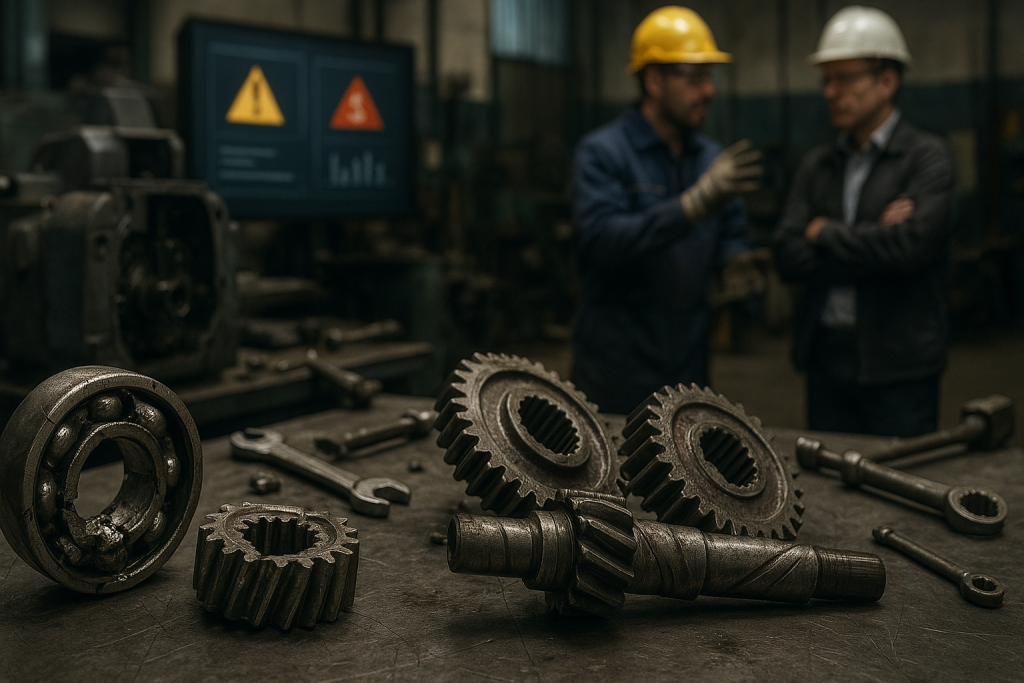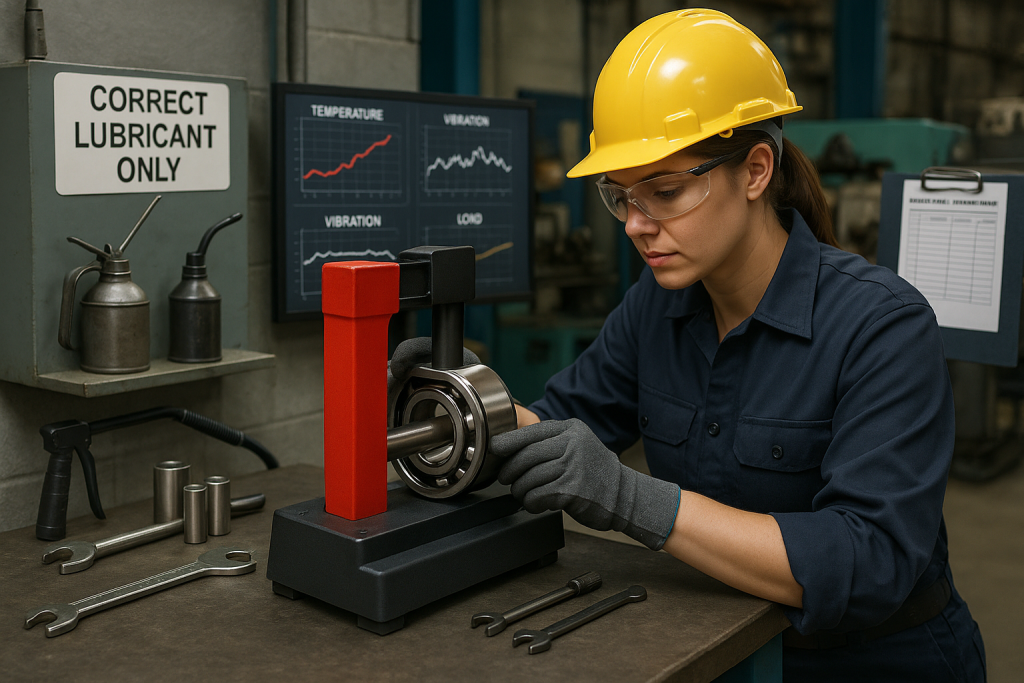Bearing failure is just an inconvenience, right?
More like a threat to your entire operation.
Whether you’re managing a manufacturing line, industrial HVAC system, mud pump or farm equipment, a defective component can bring everything to a halt. What seems like a small part can trigger a chain reaction of equipment damage, unplanned downtime, and safety risks.
Fortunately, most mechanical breakdowns are preventable.
From poor lubrication to excessive loads on undersized or misaligned components, the root causes are often avoidable with the right approach. The challenge is that these issues develop quietly… until they become a crisis. Knowing the signs and acting early can dramatically reduce costly disruptions.
This guide equips plant managers, technicians, and procurement teams with a clear plan of action. We’ll cover the real costs of premature failure, top causes of bearing malfunctions, and how to stop problems before they escalate. You’ll discover how to identify risks early–and how to choose the right partner to help when replacement becomes necessary.
The True, Hidden Cost of Bearing Failure: What Damage Does it Cause?

Bearing failure often triggers more than just the need for a replacement part. The true damage runs deeper: into your equipment, your productivity, and your bottom line. Let’s take a look at five of the most devastating consequences to guard against:
1. Mechanical Compromise
When a bearing fails, it can severely damage the shaft, housing, or other connected components, including other bearings, leading to warped parts, scoring, or even fractures that require full component replacement. This structural damage undermines the integrity of your equipment and escalates maintenance costs.
2. Equipment Damage
Broken or jammed bearings, especially in industrial, complex applications, can create cascading issues across adjacent systems. Gears, belts, and motors may suffer from misalignment or impact shock, turning a single failure into a complex repair job.
3. Financial Impact
The cost of bearing failure goes well beyond the price of a replacement part. You’re also looking at downtime, labor overtime, and the potential loss of revenue from missed production.
4. Energy Efficiency Losses
As bearings deteriorate, they create drag on the system. This friction raises energy consumption, lowers efficiency, and increases wear on other components, especially under high operating temperatures or excessive vibration.
Sudden bearing malfunctions–especially under load–can lead to high-risk scenarios for nearby personnel. Equipment that suddenly halts or breaks down can create a dangerous work environment if not properly contained or anticipated.
Understanding these consequences makes it clear why proactive bearing management matters. Let’s look at what causes bearing failure next.
8 Most Common Causes of Bearing Failure (& How to Spot Them Early)

While these mechanical components are designed to withstand heavy loads and high speeds, even small issues can spiral into costly breakdowns if not addressed early.
Below are the eight most frequent reasons bearings fail, plus practical tips to identify them before they cause bigger problems.
1. Improper Lubrication
Lack of lubrication or using the wrong type can result in metal-on-metal contact, leading to excessive heat, noise, vibration and rapid wear. You might notice discoloration or scoring on the raceways, a burnt smell, or an increase in operating temperature. Always follow manufacturer specs for grease type and re-lubrication intervals.
Bearings are designed with specific load ratings. If a bearing is subjected to forces beyond its intended limits–whether static or dynamic–it will fail prematurely. Flattened rolling elements, spalling, or fatigue cracks are telltale signs. Check system loads, and when in doubt, size up or consult a bearing distributor for more robust alternatives.
Using excessive force during installation, or misaligning the bearing on the shaft, can cause deformation or internal stress. Signs of this include cracked rings, dented raceways, or unusual noise right after startup. Use proper tools like bearing heaters or presses, and always follow precision alignment protocols.
4. Contamination
Foreign particles such as dirt, dust, or moisture can enter the bearing and destroy the smooth rolling action. Contaminated bearings often show pitting, scratches, or uneven wear. Use sealed or shielded bearings in dirty or corrosive environments and practice clean installation techniques to minimize the risk.
5. High Operating Temperatures
Elevated temperatures accelerate lubricant degradation and can cause thermal expansion in the inner and outer rings, reducing internal clearances and increasing wear. Overheating can lead to discoloration, softening of bearing materials, and eventual failure. You may notice lubricant breakdown, excess noise, or component seizure.
6. Vibration During Storage or Operation
Excessive vibration or small oscillatory movements, even when equipment is not running, can cause a condition called false brinelling–depressions or wear marks on the raceways that may appear as lines or striations.
Like true brinelling, these marks often appear at intervals corresponding to the rolling elements’ positions when the vibration occurred. This kind of damage often occurs because of excessive static loads or impact loads that exceed the elastic limit of the bearing material. Imagine dropping a heavy object on a stationary machine, or applying an unsuitably high load during installation.
7. Poor Handling or Storage
Even before installation, bearings can be damaged by moisture exposure, vibration, or improper packaging. Corrosion, true brinelling (distinct, regularly spaced indentations), or spalling are common results of poor handling.
Always store bearings in a clean, dry place, and rotate inventory to use older stock first, FIFO. Handle parts with care to avoid microfractures from impact.
8. Improper Shaft or Housing Fits
When a bearing doesn’t seat correctly on the shaft or in the housing, it can lead to distortion, slippage, or excessive preload. Fits that are too tight may deform the inner or outer ring, while overly loose fits can allow for movement that causes wear or misalignment. Out-of-square spacers and inaccurate shaft shoulders further compound these issues.
When these issues aren’t addressed, bearing failure becomes a matter of when, not if.
So, what are our options then?
Time to Replace Aging Parts? We’ve Got You Covered…
The longer a bearing operates under less-than-ideal conditions, the greater the risk to your operation. Common signs it’s time to outright replace a bearing include:
- Unusual noise or increased vibration
- Heat buildup or visible discoloration
- Excessive wear paths on rolling elements or raceway edges
- Surface scoring, flaking, or spalling
- Grease leakage, rust, or signs of contamination
Even if bearings are still functioning, performance degradation can create costly inefficiencies. Aging parts cost more in lost productivity than new ones cost to replace.
When you reach out to Central Surplus, we help you source the exact item you need, with rapid shipping and satisfaction guaranteed. Whether you know the part number or need help measuring it, our team can help you avoid costly downtime.
Already know the part you’re looking for? Check out our vast inventory on eBay!
Use These 5 Best Practices to Prevent Bearing Failure

Preventing bearing breakdowns starts with intentional design, careful installation, and proactive maintenance. Whether you’re managing industrial equipment or MRO procurement, these proven strategies will help you increase operational uptime and maximize the life of every component in your system.
1. Proper Selection & Design
Choose the right type of bearing based on application-specific parameters like load, speed, temperature, and environmental exposure. For example, spherical bearings, roller bearings, and pillow block bearings each serve different mechanical functions.
For harsh or contaminated environments, consider integrally sealed bearings or those with C3 internal clearance to account for thermal expansion. Always match the bearing’s tolerances and material specifications to the demands of your equipment.
2. Lubrication Management
Lubricant failure is one of the leading causes of premature bearing wear. Use only the grease or oil recommended by the bearing manufacturer, and follow the proper re-lubrication intervals.
Over-lubrication can cause churning and overheating, while under-lubrication leads to metal-on-metal contact. Avoid mixing incompatible lubricants, and consider centralized lubrication systems for equipment with hard-to-reach components.
3. Correct Mounting Practices
Improper installation methods–like using a hammer or forcing a bearing into place–can cause brinelling, misalignment, and internal stress. Always use proper MRO parts precision mounting tools such as arbor presses, bearing heaters, and sleeve sets.
Confirm correct shaft & housing fits, and avoid overloading by ensuring concentric installation. For applications requiring secure axial placement, clamping nuts and press fits can be used–just make sure they’re applied per spec.
4. Temperature & Load Monitoring
High operating temperatures and overload conditions drastically shorten bearing lifespan. When heat increases, internal clearance tightens, leading to accelerated wear.
Utilize infrared sensors or smart monitoring tools to detect abnormal temperature rises or vibration signals. Load sensors and overload relays can alert operators before conditions become damaging, especially in high-speed or high-load environments.
5. Routine Inspections & Preventative Measures
Schedule routine maintenance checks and re-lubrication during planned downtimes. Inspect for signs of misalignment, unusual noise, or surface wear. Bearings approaching their rated fatigue life should be replaced proactively–waiting until they fail can result in collateral damage to other machinery.
Keeping detailed maintenance logs can help identify early warning signs and extend service intervals without compromising reliability.
These best practices don’t just reduce downtime; they reduce costs, extend equipment lifespan, and protect your reputation.
Your 5 Bearing Failure Questions Answered Helping You Troubleshoot Faster
Sometimes you just need a quick answer. Here are some common questions we hear:
1. How long should a bearing last?
It depends on load, speed, and environment, but a quality bearing under ideal conditions can last millions of revolutions. Fatigue life is often calculated using dynamic load ratings. Longevity also improves significantly when the bearing is properly installed, lubricated, and monitored during operation.
2. What’s the difference between dynamic and static load ratings?
Dynamic load ratings (Cr) apply to rotating bearings, while static load ratings (C0r) measure resistance to deformation when stationary. Understanding both is critical for selecting the right bearing based on whether your application is mobile or remains idle under heavy load.
3. Can I just clean and reuse a damaged bearing?
Reusing a damaged bearing can lead to early failure. Always inspect carefully–if the surfaces are scored, the grease contaminated, or there’s excessive wear, replace it. Even small imperfections in the raceway can compromise performance and shorten service life.
4. Why is my bearing making noise?
Noise often signals improper lubrication, misalignment, or contamination. Investigate and address it immediately before more damage occurs. In many cases, audible changes are the earliest indicator of internal bearing breakdown, so don’t ignore them.
5. What’s the best way to store spare bearings?
Store in a dry, clean environment in original packaging. Rotate bearings during long-term storage to avoid false brinelling. Also, avoid storing near sources of vibration or magnetic fields, which can cause unintended movement or damage.
Your Trusted Source: Where to Turn for New Bearings that Last

At Central Surplus, we specialize in high-quality, hard-to-find, and ready-to-ship industrial components. Whether you need stainless steel bearings for harsh environments or rolling element bearings for precision applications, we’ve got you covered.
Our team understands how costly equipment failure can be–and how vital it is to get the right replacement fast. That’s why we prioritize service, selection, and speed across every order.
Need help finding the right fit?
Browse our extensive stock on eBay or reach out directly to our sourcing experts. We’ll help you get back up and running–quickly, affordably, and with confidence.



